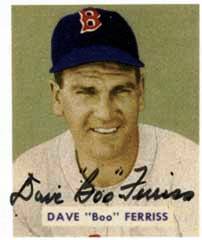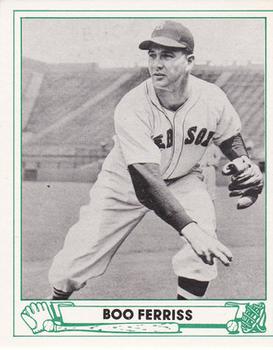May 31, 1945: Boo Ferriss wins seventh consecutive game to start career
 Dave “Boo” Ferriss, began his major-league career with an astonishing eight consecutive wins in 1945. The start of his career was as unlikely as any player before
Dave “Boo” Ferriss, began his major-league career with an astonishing eight consecutive wins in 1945. The start of his career was as unlikely as any player before him, since Ferriss had minimal time as a professional player prior to his debut. In his first six starts for the Boston Red Sox, Ferriss hurled four shutouts and two additional complete games, including a record 22 1/3 consecutive scoreless innings.
him, since Ferriss had minimal time as a professional player prior to his debut. In his first six starts for the Boston Red Sox, Ferriss hurled four shutouts and two additional complete games, including a record 22 1/3 consecutive scoreless innings.
Pitching on three days’ rest for the second start in a row, Ferriss drew the starting assignment against the Cleveland Indians in a Thursday afternoon game on May 31. The Tribe was the sixth different team he faced in his seven starts.
The Red Sox and Indians were embroiled in a fight for fifth place in the American League. Right-hander Red Embree (3-3) was the starting pitcher for the Indians that day.
For the first time in Ferriss’s seven starts for the season, the Red Sox trailed in the score. The Indians scored first in the 4th inning on Frankie Hayes’ single that sent Felix Mackiewicz home. The Indians added an unearned run in the 5th inning when Dutch Meyer doubled, followed by Red Embree reaching base on a wind-blown flyball error by Red Sox right fielder Johnny Lazor, which allowed Meyer to score.
However, the Red Sox rebounded in the bottom of the 5th inning by scoring five runs on five hits including a two-run home run by George Metkovich and a two-run double by Johnny Lazor. The Red Sox added one more run in the 7th on a RBI single by Jack Tobin.
Ferriss struck out three and issued three walks in the 6-2 Red Sox victory before 4,306 fans at Fenway Park.
He continued to show his hitting prowess by contributing two hits in four at-bats, although he didn’t factor in any of the run-scoring situations by the Red Sox. At that point in the season, Ferriss sported a lofty .444 batting average and .545 on-base percentage, which included four hits as a pinch-hitter.
He further intrigued baseball fans by the fact he was ambidextrous. Nicknamed “The Meal Ticket,” the Daily Boston Globe reported that he worked out at first base in pregame warmups. He fielded and threw left-handed, looking as natural as he did as a right-handed pitcher.1 However, Ferriss never did appear in a major league game as a left-handed pitcher or first baseman.
In describing Ferriss’s popularity in New England and fans across the nation, The Sporting News used a carnival ferriss wheel as an analogy for Ferriss’s thrilling consecutive winning streak over six different opponents, “Round and round the Ferriss wheel goes, and where it stops nobody knows.” Ferriss, an ex-G. I., was also a favorite of sportswriters during wartime baseball.2
When Ferriss had been first called up to the Red Sox in late April, there were no available lockers in Fenway Park, so he was assigned an area by the bat rack that had two nails on the locker room wall on which he hung his street clothes and uniform. Despite a claim that he was not superstitious, Ferriss had no desire to move to a recently vacated locker, on the chance it would change his luck on the field. For the same reason, Red Sox clubhouse assistant Johnny Orlando was in no hurry to relocate Ferriss either.3
At midseason Ferriss was on pace for a 30-win season, but he struggled with asthma during the last two months and had to settle for a 21-10 record. Many observers surmised that Ferriss’s success was due in large part to having faced weak lineups of opposing teams because of the shortage of experienced players during the war.
However, Ferriss proved he was no fluke by winning 25 games in 1946 when all of the soldiers had returned from the war and team rosters were largely restored with its prewar players. He would lead the American League with a winning percentage of .806, while helping the Red Sox to their first pennant since 1918.
Ferriss’s career was cut short by an arm injury suffered during the 1947 season. Consequently, he would make only nine major league starts from 1948 to 1950. He was the pitching coach for the Red Sox from 1955 to 1959. Despite his shortened career, he was elected to the Boston Red Sox Hall of Fame in 2002.
Sources
In addition to the sources mentioned in the notes, the author also consulted:
Aaron, Marc Z.; Nowlin, Bill, eds. Who’s on First: Replacement Players in World War II (Phoenix: Society for American Baseball Research, 2015).
Cleveland, Rick. Boo: A Life in Baseball, Well-Lived (Canada: Piedmont Publishing, 2008).
Pietrusza, David; Silverman, Matthew; Gershman, Michael, eds.Baseball: The Biographical Encyclopedia (New York: Total/Sports Illustrated, 2000).
Webb, Melville. “Ferris Wins Seventh,” DailyBoston Globe, June 1, 1945: 11.
Notes
1Hy Hurwitz. “Red Sox Win Fourth Straight,” Daily Boston Globe, June 3, 1945: D18.
2 Jack Malaney. “Bosox Get Hot, Staff Catches Ferriss Fever,” Daily Boston Globe, June 7, 1945: 4:
3 Earl Banner. “’Fantastic’ Ferriss, Red Sox Pitching Sensation, Still Makes His Own Bed,” Daily Boston Globe, June 3, 1945: C5.
Additional Stats
Boston Red Sox 6
Cleveland Indians 2
Fenway Park
Boston, MA
Box Score + PBP:
Corrections? Additions?
If you can help us improve this game story, contact us.


